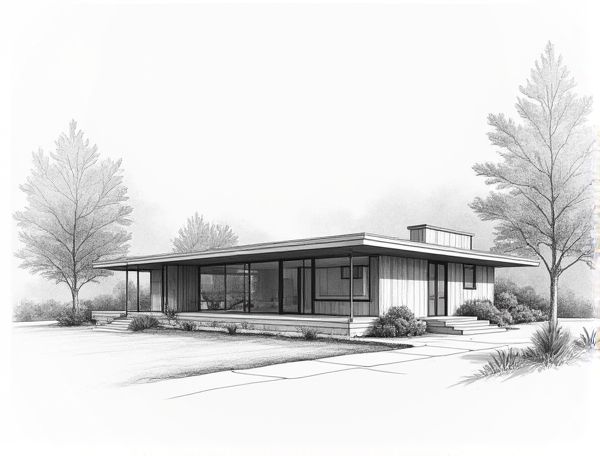
Photo illustration: Mid-century modern home design with adaptive smart glass
Mid-century modern home design seamlessly blends clean lines and organic forms with adaptive smart glass technology, enhancing natural light control and energy efficiency in your living space. Explore how this innovative fusion transforms aesthetics and functionality by reading more in the article.
Introduction to Mid-Century Modern Home Design
Mid-century modern home design features clean lines, organic curves, and a seamless integration with nature, emphasizing functionality and simplicity. Your space will benefit from large windows, open floor plans, and natural materials that create a timeless, stylish environment.
Key Features of Mid-Century Modern Architecture
Key features of mid-century modern architecture include clean lines, flat planes, and large glass windows that create a seamless connection between indoor and outdoor spaces. This design style emphasizes open floor plans, minimal ornamentation, and the use of natural materials like wood and stone to enhance functionality and aesthetic appeal.
The Rise of Adaptive Smart Glass in Home Design
Adaptive smart glass technology is revolutionizing home design by providing dynamic control over natural light, privacy, and energy efficiency through electrochromic and photochromic materials. Its integration enhances indoor comfort and sustainability by adjusting transparency levels in real-time, reducing reliance on artificial lighting and HVAC systems.
Integrating Smart Glass with Mid-Century Aesthetics
Integrating smart glass with mid-century aesthetics enhances natural light control while preserving iconic clean lines and minimalist design elements characteristic of the era. This fusion offers energy-efficient transparency adjustments that maintain privacy without compromising the timeless appeal of mid-century modern interiors.
Energy Efficiency Benefits of Smart Glass
Smart glass enhances your home's energy efficiency by regulating indoor temperatures and reducing the need for artificial heating and cooling, leading to significant savings on utility bills. By automatically adjusting to sunlight, smart glass minimizes heat gain and loss, promoting sustainable living and increasing your property's overall value.
Enhancing Natural Light with Adaptive Technologies
Adaptive technologies such as smart glass windows and automated shading systems significantly enhance natural light in home design, optimizing brightness while reducing glare and energy consumption. Incorporating sensors and AI-driven controls allows real-time adjustment of lighting conditions, creating comfortable and dynamic living spaces. These innovations not only improve indoor ambiance but also contribute to sustainable building practices by maximizing daylight utilization.
Privacy Solutions: Smart Glass vs Traditional Window Treatments
Smart glass technology offers dynamic privacy control by adjusting opacity electronically, providing seamless transitions between transparency and opacity without physical barriers, unlike traditional window treatments such as blinds or curtains that require manual operation and can limit natural light. This innovation enhances home design by integrating privacy solutions that maintain aesthetic appeal and energy efficiency while offering customizable light and visibility levels.
Smart Glass Applications in Iconic Mid-Century Interiors
Smart glass technology enhances iconic mid-century interiors by seamlessly integrating modern functionality with classic design elements. These applications allow for dynamic control of natural light and privacy, preserving the minimalist aesthetic while improving energy efficiency. Incorporating switchable glass panels and electrochromic windows transforms mid-century homes into adaptable, environmentally responsive living spaces.
Installation Considerations and Costs for Homeowners
Homeowners should evaluate installation considerations such as the compatibility of materials, structural support requirements, and local building codes to ensure a seamless integration of design elements. Costs vary significantly based on factors including the complexity of the layout, choice of premium or sustainable materials, and labor expenses in the regional market. Proper planning and obtaining multiple quotes from licensed contractors can optimize budget management and prevent unexpected financial burdens during the home design process.
Future Trends: Merging Vintage Design with Innovative Technologies
Future home design trends embrace the seamless integration of vintage aesthetics with cutting-edge technology, offering you timeless elegance enhanced by smart home automation and energy-efficient systems. This fusion creates spaces that honor historical charm while optimizing functionality and sustainability for modern living.
 homedesy.com
homedesy.com